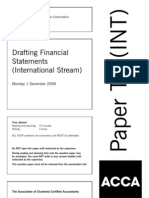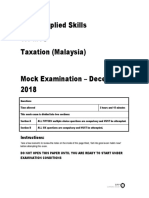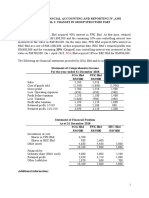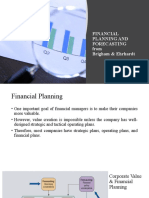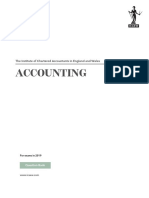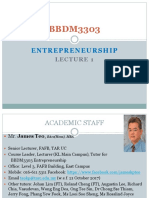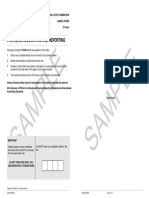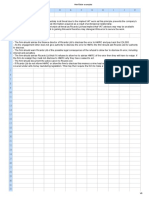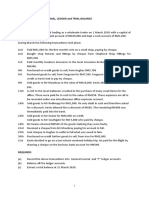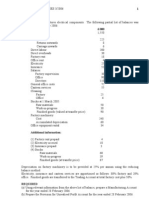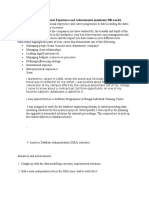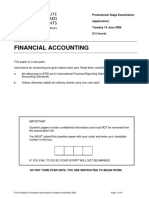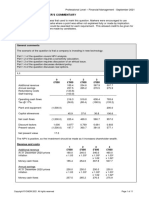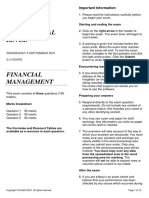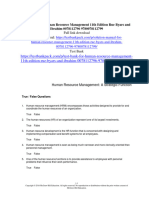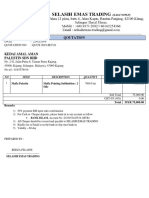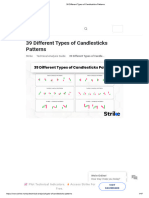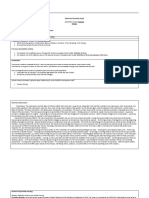Professional Documents
Culture Documents
Financial Accounting IFRS Student Mark Plan June 2019
Uploaded by
scottCopyright
Available Formats
Share this document
Did you find this document useful?
Is this content inappropriate?
Report this DocumentCopyright:
Available Formats
Financial Accounting IFRS Student Mark Plan June 2019
Uploaded by
scottCopyright:
Available Formats
Professional Level – Financial Accounting and Reporting – June 2019
MARK PLAN AND EXAMINER’S COMMENTARY
The marking plan set out below was that used to mark this question. Markers were encouraged to use
discretion and to award partial marks where a point was either not explained fully or made by implication.
More marks were available than could be awarded for each requirement. This allowed credit to be given for a
variety of valid points which were made by candidates.
Question 1
Total Marks: 33
General comments
Part 1.1 of this question tested the preparation of a statement of profit or loss and a statement of financial
position from a list of balances plus a number of adjustments. A note showing the movements on
intangible assets for the year was also required. Adjustments related to intangible assets, the acquisition
of a sole trader, borrowing costs, depreciation charges and an under-provision for income tax. Part 1.2
required a description of the differences between IASs 23 and 38 and UK GAAP. Part 1.3 required an
explanation of the accrual basis of accounting using examples from Part 1.1.
1.1 Grouper Ltd
(a) Statement of profit or loss for the year ended 31 December 2018
£
Revenue 3,125,800
Cost of sales (W1) (2,505,930)
Gross profit 619,870
Administrative expenses (W1) (364,920)
Distribution costs (89,100)
Profit before tax 165,850
Income tax (8,000 + 5,300) (13,300)
Profit for the year 152,550
(b) Statement of financial position as at 31 December 2018
£ £
ASSETS
Non-current assets
Property, plant and equipment (W3) 655,210
Intangible assets (505,010 + 46,600) (c) 551,610
1,206,820
Current assets
Inventories 150,200
Trade and other receivables (254,740 + 25,100 – 15,060 264,780
(W1))
414,980
Total assets 1,621,800
Equity
Ordinary share capital 400,000
Retained earnings (782,800 + 152,550) 935,350
1,335,350
Current liabilities
Trade and other payables (160,300 + 3,750 (W3)) 164,050
Borrowings (100,000 + 14,400) 114,400
Taxation 8,000
286,450
Total equity and liabilities 1,621,800
Copyright © ICAEW 2019. All rights reserved Page 1 of 16
Professional Level – Financial Accounting and Reporting – June 2019
(c) Note to the financial statements as at 31 December 2018 – Intangible assets
Development Goodwill
costs
£ £
Cost
At 1 January 2018 502,800 -
Additions (((297,000 – 25,000) x 3/12) + 1,250) (W3) 69,250 46,600
At 31 December 2018 572,050 46,600
Amortisation
At 1 January 2018 - -
Charge for the year (502,800 ÷ 5 x 8/12) 67,040 -
At 31 December 2018 67,040 -
Carrying amount
At 31 December 2017 502,800 -
At 31 December 2018 505,010 46,600
Workings
(1) Allocation of expenses
Cost of Administrative Distribution
sales expenses costs
£ £ £
Per TB 2,055,200 349,860 89,100
Amortisation (c) 67,040
Opening inventories 120,600
Closing inventories (150,200)
Research costs ((297,000 – 25,000) x 204,000
9/12)
Depreciation (38,050 + 171,240) (W3) 209,290
Bad debt (25,100 x 60%) 15,060
2,505,930 364,920 89,100
(2) Purchase of sole trader
£
Consideration 300,000
Less: Fair value of net assets acquired (253,400)
Goodwill 46,600
(3) Property, plant and equipment
Cost Accumulated
depreciation
£ £
Per TB 856,200 501,500
Development machine 25,000
Depreciation on development machine (25,000 ÷ 5 x 3/12) 1,250
Sole trader PPE 228,300
Depreciation on sole trader PPE (228,300 ÷ 3 x 6/12) 38,050
Depreciation on remaining PPE (856,200 ÷ 5) 171,240
Construction costs 254,000
Accrued interest on borrowings (100,000 x 5% x 9/12) 3,750
1,367,250 712,040
Carrying amount 655,210
Copyright © ICAEW 2019. All rights reserved Page 2 of 16
Professional Level – Financial Accounting and Reporting – June 2019
Most candidates made a good attempt at this question with almost all candidates presenting a statement
of profit or loss and statement of financial position. A majority of candidates presented well laid out
statements with a good proportion completing their statements with totals. This question also required the
preparation of the intangible assets note – this was less well done with only a minority of candidates
presenting a note that looked anything like that which would be included in a published set of financial
statements.
Almost all candidates correctly included revenue at an unadjusted figure. The tax figure caused some
confusion with candidates only putting in the liability for the year, or the under-provision from the previous
year or deducting the under-provision rather than adding it. Only a minority of candidates arrived at the
correct tax charge for the year. More arrived at the correct figure for the statement of financial position, but
it was common to see the under-provision included here instead of in the tax charge.
Candidates generally made the correct adjustments to the trade receivables figures although a significant
minority showed the bad debt allowance as part of current liabilities (sometimes in addition to deducting it
from trade receivables). The overdraft caused some confusion as a significant number of candidates
missed that the bank account was overdrawn and showed the balance as part of current assets, whilst
others showed it as a negative balance in current liabilities.
The bank loan (and sometimes also the accrued interest) was often presented in non-current liabilities
even though the question clearly stated that the loan was due to be repaid on 31 December 2019.
The property, plant and equipment working was generally well done. Marks were most commonly lost
because candidates omitted to include the development machine or the sole trader plant and equipment.
A significant number of candidates worked out the depreciation on these two figures correctly but did not
then include them in the total for property, plant and equipment. Another common error was the omission
of the capitalised borrowing costs, even where this had been calculated.
The area that caused the greatest problem with this question was the intangible assets note, along with
the related figure for research costs that needed expensing. Only a minority of candidates appreciated that
goodwill formed part of the note. A significant number of candidates correctly calculated the goodwill figure
but then did not take the balance anywhere. Others, instead of calculating goodwill, included the full
£300,000 consideration, or the £300,000 adjusted for the sole trader’s bad debt allowance and
depreciation on the plant and equipment, within investments.
Other common errors here included:
deducting the machine used for development from the costs for the year before taking a
proportion of those costs to the note, but then adding back that figure later in the table
using the wrong split of months when apportioning the costs to research and to development
amortising the costs on the completed project for a whole year instead of for six months
not capitalising the depreciation on the machine used for development.
A majority of candidates prepared a separate costs matrix working, which generally is the most efficient
working to ensure that they are awarded all the marks available for this. Occasionally candidates prepared
this working in brackets on the face of the statement of profit or loss, but this is less clear and can lead to
marks being lost. As usual, a minority of candidates lost marks by showing their base figures as negatives
and then getting confused half way through the calculation and losing marks because adjustments were
made in the wrong direction.
As ever, many candidates lost marks by not showing workings and/or failing to include an audit trail, in
particular in respect of the property, plant and equipment and/or intangibles figures on the face of the
statement of financial position and the depreciation charges in the costs matrix.
Total possible marks 26
Maximum full marks 26
Copyright © ICAEW 2019. All rights reserved Page 3 of 16
Professional Level – Financial Accounting and Reporting – June 2019
1.2 Differences between IAS 23 and IAS 38 and UK GAAP
UK GAAP IFRS
IAS 23 Borrowing Costs
Under FRS 102 an entity can choose whether or not IAS 23 gives no such choice. Capitalisation is
to capitalise borrowing costs required.
.
IAS 38 Intangible Assets
Under FRS 102 an entity can choose whether or not IAS 38 requires all (eligible development) costs to
to capitalise development costs. be capitalised.
FRS 102 treats all intangible assets as having a finite Under IAS 38 intangibles can have an indefinite
useful life/required to be amortised, with a rebuttable life in which case they should be reviewed
presumption that this should not exceed ten years. annually for impairment.
Most candidates made a reasonable attempt at the UK GAAP differences although a significant minority of
candidates managed to get all of the differences the wrong way round.
The most common error/misunderstanding was that under IFRS intangible assets are never amortised and
instead are always subject to annual impairment reviews. A significant number of candidates also wrongly
stated that under UK GAAP intangible assets should always be amortised over 10 years. Others lost
marks by describing the differences in relation to development costs as applying more generally to all
intangible assets.
Total possible marks 4
Maximum full marks 3
1.3 Accrual basis of accounting
The accrual basis of accounting records transactions in the period in which they occur, rather than when
the cash inflow or outflow arises. Under the accrual basis an entity recognises items as assets, liabilities,
equity, income and expenses when they satisfy the definition and recognition criteria for those elements in
the IASB Conceptual Framework.
Possible examples from Grouper Ltd:
The charging of depreciation on plant and equipment. The depreciation is charged over the useful life of
the asset, so that at the end of its life the asset will be written down to zero. This recognises that Grouper
Ltd is generating economic benefits from the asset over its useful life, hence matching the income with the
cost of the asset.
The charging of amortisation on the development costs. The amortisation is charged to reflect the pattern
in which the asset’s future befits are consumed, so that at the end of its life the asset will be written down
to zero. Hence Grouper Ltd should charge amortisation on the costs of Project X over the five year “life” of
the project, hence matching the income from the project with the costs of development.
The recognising of revenue. Under the accruals basis of accounting, Grouper Ltd’s revenue will have been
recorded in the period in which the risks and rewards passed from Grouper Ltd to the buyer, not when
Grouper Ltd receives full payment. This means that credit sales that they make will be recorded earlier
than if a cash basis of accounting had been used.
The capitalisation of borrowing costs recognises that this was a cost of constructing the asset. Like other
costs it should be spread over the useful life of the machine. This will be done via an increased
depreciation charge.
Copyright © ICAEW 2019. All rights reserved Page 4 of 16
Professional Level – Financial Accounting and Reporting – June 2019
The adjustments for opening and closing inventories ensure that not all the purchases made during the
year are charged against sales as not all of those purchases were sold during the year. This adjustment
matches the true cost of sales to the sales made.
Accruals for the tax liability/interest payable match costs for the year not yet paid, with the revenue for that
year.
This was the concepts part of the question which can lead to quite mixed answers. However, on this
occasion most candidates made a reasonable attempt at the question, giving a brief explanation and then
two reasonable examples of the accrual basis relevant to the scenario. Weaker candidates struggled with
the examples giving somewhat confused explanations.
Total possible marks 5½
Maximum full marks 4
Copyright © ICAEW 2019. All rights reserved Page 5 of 16
Professional Level – Financial Accounting and Reporting – June 2019
Question 2
Total Marks: 27
General comments
Part 2.1 of this question required candidates to explain the financial reporting treatment of four accounting
issues given in the scenario. The issues covered the purchase of a machine on credit in a foreign
currency, the valuation of inventories, a financial asset and a bonus issue of shares. Part 2.2 required the
calculation of revised profit and EPS figures. Part 2.3 required a discussion of the ethical issues arising
from the scenario.
2.1 Medaka plc
(1) Foreign exchange transaction
IAS 21, The Effects of Changes in Foreign Exchange Rates, requires a foreign currency transaction to be
recorded on initial recognition in the “functional currency” (ie that of the primary economic environments in
which the entity operates, so here £) using the exchange rate at the date of the transaction/at 1 July 2018.
So Jim should have recorded the transaction at the delivery date/1 July 2018, as that is when the risks and
rewards of ownership passed/control was achieved, as the seller remained responsible for the insurance
of the machine until Medaka plc took delivery. However, Jim has incorrectly translated at the order date,
debiting property, plant and equipment and crediting payables with £468,160 (€585,200 x 0.80). He should
have recorded the transaction at £497,420 (€585,200 x 0.85), meaning that both property, plant and
equipment and trade payables are understated by £29,260 (497,420 – 468,160).
When the supplier was paid this would have been at £509,124 (€585,200 x 0.87), leaving a difference of
£11,704 (509,124 – 497,420) in payables. This figure needs debiting to expenses, as it is a realised loss.
Jim should not have retranslated the machine at the year end as this is a non-monetary item. Therefore
the machine should remain at £497,420, not the revised figure of £526,680 (€585,200 x 0.90). Since Jim
originally recorded the purchase on the order date, and hence at £468,160 (€585,200 x 0.80) he has taken
£58,520 (526,680 – 468,160) to profit and loss, and this should be reversed.
Per IAS 16, Property, Plant and Equipment, the machine should also have been depreciated over its 10
year useful life, as increases in value are irrelevant to a depreciation charge, although the company could
choose to revalue. Depreciation should be charged for six months of the year only/from 1 July 2018. The
charge for the year should therefore be £24,871 (497,420 x 6/12 x 10%). The carrying amount of the
machine at the year end will therefore be £472,549 (497,420 – 24,871).
(2) Valuation of inventories
Per IAS 2, Inventories, fixed production overheads should be allocated on the basis of normal production
capacity. Jim has valued finished goods to include £46,000 ((£460,000/20,000) x 2,000) in respect of fixed
production overheads whereas they should have included £28,750 ((£460,000/32,000) x 2,000). Closing
inventories are therefore overstated by £17,250 (46,000 – 28,750), as is profit for the year.
(3) Financial asset
The zero coupon bond is a financial asset and should be recognised when Medaka plc enters into a
contractual provision of the financial instrument, which we assume to be 1 January 2018.
The bond should initially be measured at its fair value. Fair value is the price you would receive to sell the
financial asset in an orderly transaction between market participants at the measurement date. Fair value
is assumed to be the price paid/of £181,440 for the bond as it is quoted in an active market.
Transaction costs, such as brokers’ and professional fees, should be included in the bond’s initial carrying
amount. Hence the bond should initially have been recognised at £186,440 (181,440 + 5,000).
After initial recognition at fair value the financial asset should be measured at amortised cost using the
effective interest method.
Copyright © ICAEW 2019. All rights reserved Page 6 of 16
Professional Level – Financial Accounting and Reporting – June 2019
Amortised cost is:
The initial amount recognised for the financial asset, being £186,440
Less any interest received of which there is none as the bond is zero coupon
Plus any amortisation, using the effective interest rate of 4%.
£
Initial fair value 186,440
Add: Amortisation (186,440 x 4%) 7,458
Carrying amount at 31 December 2018 193,898
Jim has recognised the bond at £209,720 (196,000 x 107%). So he must have taken a credit of £23,280
(209,720 – 186,440) to profit or loss. This should be reversed.
The year-end carrying amount should be recognised as part of non-current assets. Interest receivable of
£7,458 should be recognised in the statement of profit or loss for the period.
(4) Bonus issue
Given that the directors wish to maximise distributable profits, as much of this bonus issue as possible
should be debited to the share premium account and the balance to retained earnings. 100,000
(500,000/5) shares were issued. Therefore £75,000 should have been debited to share premium and
£25,000 to retained earnings with £100,000 going to share capital. Ordinary share capital at 31 December
2018 is therefore £600,000, share premium is nil, and retained earnings are £5,472,133 (5,625,300 –
25,000 ½ = 5,600,300 + (433,033 – 561,200) ½ (2.2)).
Jim should also have taken the bonus issue into account in his EPS calculation. So the calculation should
have been based on 600,000 ordinary shares, and the number of shares should have been calculated as
if the bonus shares had always been in existence/bonus issue added in for the whole year.
This was reasonably well answered with most candidates covering all four issues. Where an issue was
missed out this was most commonly Issue (3), the financial instrument. Pleasingly, following previous
examiner’s reports, fewer candidates than usual wasted time writing out journal entries (which were not
required). It was also less common than usual to see answers which consisted mainly of calculations with
little narrative explanation. A significant minority of candidates managed to achieve full marks on this part.
Issue (1): This was generally well answered with almost all candidates discussing both the foreign
currency issues and the need to depreciate the machine. However, answers were often poorly structured
and lacked clarity with a number of candidates calculating figures almost randomly without any proper
explanation of when the figures should be or had been used.
Whilst the majority of candidates correctly identified the various errors that had been made and made a
good attempt at calculating the correct figures, they were less skilled at explaining how the original errors
should be corrected. Most candidates identified the need to depreciate the machine from the acquisition
and calculations were generally accurate with the correct figure seen more often than not.
Issue (2): This was very well answered with many candidates gaining all the marks available by explaining
that fixed production costs should be absorbed using the normal production capacity and calculating the
correct adjustment to closing inventories (although this was often made in the wrong direction in Part 2.2).
A minority of candidates just calculated the correct closing figure, and not the adjustment needed.
Issue (3): This was not well answered. Many candidates thought this was a financial liability and wasted
time treating it like a compound instrument. Few recognised that issue costs should be added to the fair
value of the asset rather than being expensed and few explained clearly the correct treatment at amortised
cost. However, most did recognise that interest should be calculated using the effective interest rate. It
was rare to see the correct calculation of the adjustment needed to correct the incorrect treatment by the
financial director.
Issue (4): This was generally well answered with nearly all candidates explaining the correct treatment of
the share issue. However, only a minority of candidates explained why the share premium account would
be debited before retained earnings. A worrying minority charged that part of the bonus issue which could
not be covered by the share premium account to the profit for the year.
Copyright © ICAEW 2019. All rights reserved Page 7 of 16
Professional Level – Financial Accounting and Reporting – June 2019
Total possible marks 33
Maximum full marks 18
2.2 (a) Revised profit for the year
£
Draft profit 561,200
(1) Realised loss on settlement of payable (11,704)
(1) Exchange gain on machine incorrectly recognised (58,520)
(1) Depreciation charge (24,871)
(2) Decrease in closing inventories (17,250)
(3) Bond incorrectly recognised (23,280)
(3) Income re bond 7,458
433,033
(b) Revised EPS
Profit for the year £433,033
Number of shares 600,000
= EPS 72.2p
This part was generally well answered with quite a few candidates achieving full marks. As always it was
sometimes difficult to match the adjustments made to profit back to the figures calculated in Part 2.1. The
most common mistake was to adjust profit for the part of the bonus issue taken to retained earnings.
Nearly all candidates calculated an EPS figure using their adjusted profit. However, many wasted time
doing a weighted average table for the number of shares rather than just using the number after the bonus
issue (even where they had stated in Part 2.1 that the bonus issue should be treated as if it had been in
place from the start of the year).
Total possible marks 4½
Maximum full marks 4
Copyright © ICAEW 2019. All rights reserved Page 8 of 16
Professional Level – Financial Accounting and Reporting – June 2019
2.3 Ethical issues
Both myself and Jim are ICAEW Chartered Accountants so should comply with the ICAEW Code of
Ethics. As an ICAEW Chartered Accountant Jim has a duty of professional competence and should have
kept himself up to date. He should therefore be aware of the correct IFRS financial reporting treatment for
all of these issues, none of which are at all controversial.
However, Jim appears to have a self-interest threat, as he is due a bonus based on the EPS for the year.
The “errors” in the draft financial statements could be genuine mistakes due to a lack of knowledge, or
could be a deliberate attempt by Jim to overstate the profit for the year, understate the number of shares
and hence overstate EPS in order to increase his bonus. The fact that the net effect of each of these
issues is to either increase profit or decrease the number of shares, may add weight to the theory that the
errors may have been deliberate.
It is possible that I might feel intimated by Jim, as he is my superior and face a potential intimidation threat.
However, I have already spoken to the other directors so this seems unlikely.
I should take the following steps:
Report back to the directors as to the errors that have been made
If they ask me to, explain to Jim how each of these matters should be accounted for.
If they appear to be genuine errors suggest to the other directors that Jim goes on an update course.
If Jim refuses to correct the errors, refer to the other directors/audit committee.
If I feel that my positon is compromised at any stage, obtain advice from the ICAEW helpline or local
members responsible for ethics.
Keep a written record of all discussions, who else was involved and the decisions made.
This part of the question, which was in a very typical style for the ethics part, was very well answered with
many candidates achieving full marks. Almost all candidates recognised the main threats of self-interest
and lack of professional competence, and used specific information from the scenario to illustrate their
answer. Most candidates were also able to list appropriate actions.
As ever, a small minority answered as if they were a member of the audit team rather than employed by
the company, which usually meant that the suggested actions were not appropriate to the scenario.
Total possible marks 11½
Maximum full marks 5
Copyright © ICAEW 2019. All rights reserved Page 9 of 16
Professional Level – Financial Accounting and Reporting – June 2019
Question 3
Total Marks: 16
General comments
This question tested the preparation of a consolidated statement of cash flows and reconciliation note,
where a subsidiary had been disposed of during the year. Missing figures to be calculated included
dividends paid to the non-controlling interest, dividends received from an associate, finance lease liabilities
paid, tax paid, the depreciation charge for the year and the amount of an impairment of goodwill
recognised during the year.
Kokopu plc
Consolidated statement of cash flows for the year ended 31 December 2018
£ £
Cash flows from operating activities
Cash generated from operations (Note) 1,234,665
Interest paid (10,250)
Income tax paid (W2) (220,740)
Net cash from operating activities 1,003,675
Cash flows from investing activities
Purchase of property, plant and equipment (956,200)
Dividends received from associate (W4) 25,000
Disposal of Rohu Ltd net of cash disposed of 741,300
(742,700 – 1,400)
Net cash used in investing activities (189,900)
Cash flows from financing activities
Repayment of finance lease liabilities (W1) (228,100)
Dividends paid to non-controlling interest (W5) (43,625)
Net cash used in financing activities (271,725)
Net increase in cash and cash equivalents 542,050
Cash and cash equivalents at beginning of period 3,600
Cash and cash equivalents at end of period 545,650
Note: Reconciliation of profit before tax to cash generated from operations
£
Profit before tax (1,026,200 + 61,890) 1,088,090
Finance cost 10,250
Share of profits of associate (56,200)
Depreciation charge (W3) 255,800
Impairments of goodwill (W6) 20,000
Increase in inventories (901,300 – 752,200) (149,100)
Increase in trade and other receivables ((599,800 + 128,075) – 603,200) (124,675)
Increase in trade and other payables ((489,200 + 99,700) – 398,400) 190,500
Cash generated from operations 1,234,665
Workings
(1) Finance lease liabilities
£ £
Cash (β) 228,100 B/d (120,500 + 40,500) 161,000
C/d (180,600 + 50,300) 230,900 PPE 298,000
459,000 459,000
Copyright © ICAEW 2019. All rights reserved Page 10 of 16
Professional Level – Financial Accounting and Reporting – June 2019
(2) Income tax
£ £
Cash (β) 220,740 B/d 201,000
C/d 198,000 CP&L (205,240 + 12,500) 217,740
418,740 418,740
(3) PPE
£ £
B/d 1,123,400 Disposal of sub – PPE 839,300
Revaluation (760,000 – 45,000 Depreciation charge (β) 255,800
715,000)
Finance leases 298,000
Additions 956,200 C/d 1,327,500
2,422,600 2,422,600
(4) Investment in associate
£ £
B/d 206,300 Cash (β) 25,000
CP&L 56,200 C/d 237,500
262,500 262,500
(5) Non-controlling interest
£ £
Cash (β) 43,625 B/d 652,400
Disposal (869,075 x 20%) 173,815
C/d 701,200 CP&L 266,240
918,640 918,640
(6) Goodwill
£ £
B/d 502,500 Disposal of sub – GW 41,200
Impairments (β) 20,000
C/d 441,300
502,500 502,500
Many candidates made a reasonable attempt at this question and gained a good number of marks where
their extracts were backed up with T-accounts. Presentation was quite mixed. At the other end of the
scale there were a large number of non-attempts on this question and some very low marks. Candidates
need to appreciate that a consolidated statement of cash flows will continue to be tested from time to time.
In the reconciliation of profit before tax to cash generated from operations hardly any candidates started
their reconciliation with the correct profit before tax figure. The most common errors were failing to include
the profit from discontinued operations in this figure and/or adjusting for the profit on disposal. A
significant number of candidates wasted time calculating the profit on disposal when it was given in the
question and was not needed for the answer.
Most candidates presented the correct figures for inventories, finance costs and the associate. Almost all
candidates included their own figure for depreciation and where errors were made in the movements on
receivables and payables it was usually due to not adjusting for discontinued operation.
On the statement itself most candidates correctly showed the interest paid figure. The tax figure was often
correct and if there was an error again it was due to ignoring or failing to deal correctly with the
discontinued operation. The figure for the purchase of property, plant and equipment was correctly
included by a majority of candidates. The proceeds from the disposal of the subsidiary was included by a
majority of candidates although a significant number missed deducting the cash disposed of with the
subsidiary and sometimes, instead, adjusted the closing cash figure for this. The calculation of the non-
controlling interest and the repayment of the finance lease liabilities caused the most problems with
Copyright © ICAEW 2019. All rights reserved Page 11 of 16
Professional Level – Financial Accounting and Reporting – June 2019
candidates often making mistakes by either missing out or adding additional figures in their T-accounts.
As ever, a number of candidates lost marks by using the incorrect sign for items included on the
statement itself or in the note. Others lost marks by not using T-account workings as it is more difficult to
see whether the direction of adjustments is correct in a columnar working, especially if the sign is wrong
on the face of the statement or in the note.
Total possible marks 17
Maximum full marks 16
Copyright © ICAEW 2019. All rights reserved Page 12 of 16
Professional Level – Financial Accounting and Reporting – June 2019
Question 4
Total Marks: 23
General comments
Part 4.1 required the preparation of the consolidated statement of financial position at the end of the year,
after a second subsidiary had been acquired. One of the subsidiaries gave rise to a gain on bargain
purchase. Consolidation adjustments included intra-subsidiary balances, unrealised profit on trading and a
fair value adjustment on acquisition (of a depreciating asset). Part 4.2 required the calculation of the
group’s non-controlling interest at the start of the year, when the group held only one subsidiary.
Opaleye plc
4.1 Consolidated statement of financial position as at 31 December 2018
£ £
Assets
Non-current assets
Property, plant and equipment (875,600 + 768,500 + 2,900) + 32,000 – 1,675,920
3,080)
Goodwill (W3) 240,400
1,916,320
Current assets
Inventories (501,400 + 356,500 + 81,300 – 1,400) 937,800
Trade and other receivables (326,800 + 201,300 + 79,200 587,800
– 19,500)
Cash and cash equivalents (32,600 + 5,400 + 200) 38,200
1,563,800
Total assets 3,480,120
Equity and liabilities
Equity attributable to owners of Opaleye plc
Ordinary share capital 1,000,000
Revaluation surplus (375,000 + (100,000 (W1) x 60%)) 435,000
Retained earnings (W6) 814,912
2,249,912
Non-controlling interest (W5) 489,608
Total equity 2,739,520
Current liabilities
Trade and other payables (285,500 + 99,200 + 69,400 – 434,600
19,500)
Taxation (205,000 + 101,000) 306,000
740,600
Total equity and liabilities 3,480,120
Workings
(1) Net assets – Perch Ltd
Year end Acq Post acq
£ £ £
Share capital 500,000 500,000
Revaluation surplus 150,000 50,000 100,000
Retained earnings
Per Q 481,500 110,600
FV adj 32,000 32,000
Deprec thereon ((22,000 ÷ 50) x 7) (3,080) 367,820
1,160,420 692,600 467,820
Copyright © ICAEW 2019. All rights reserved Page 13 of 16
Professional Level – Financial Accounting and Reporting – June 2019
(2) Net assets – Tetra Ltd
Year end Acq Post acq
£ £ £
Share capital 100,000 100,000
Retained earnings
Per Q (5,800) (17,500)
PURP (19,500 – 18,100) (1,400)
92,800 82,500 10,300
(3) Goodwill – Perch Ltd
£
Consideration 650,000
Non-controlling interest at acquisition (FV) 300,000
Net assets at acquisition (W1) (692,600)
257,400
Less: Impairments (12,000 + 5,000) (17,000)
240,400
(4) Goodwill – Tetra Ltd
£
Consideration 25,000
Non-controlling interest at acquisition (82,500 (W2) x 10%) 8,250
Net assets at acquisition (W2) (82,500)
Gain on bargain purchase (49,250)
(5) Non-controlling interest
£ £
Perch Ltd
NCI at acquisition 300,000
Share of post-acq reserves (467,820 (W1) x 40%) 187,128
Less: Share of impairments (40% x 17,000 (W3)) (6,800)
480,328
Tetra Ltd
NCI at acquisition (W4) 8,250
Share of post-acq reserves (10,300 (W2) x 10%) 1,030
9,280
489,608
(6) Retained earnings
£
Opaleye plc 545,900
Perch Ltd (367,820 (W1) x 60%) 220,692
Tetra Ltd (10,300 (W2) x 90%) 9,270
Less: Share of impairments (60% x 17,000 (W3)) (10,200)
Gain on bargain purchase (W4) 49,250
814,912
There were many excellent and well laid out answers to this question with most candidates using the
standard workings. It was common to see completely correct figures in the net asset tables and goodwill
workings, although slightly less often for the non-controlling interest figure where the fair value method
was being used.
The issue that caused the most problems was the impact of the movement on the subsidiary’s revaluation
surplus. Many candidates completely ignored this in equity or took the total movement or the closing
balance on the subsidiary’s revaluation surplus. Very few realised that the post-acquisition movement
taken to consolidated retained earnings should exclude the movement on this reserve, although most did
include it in the post-acquisition movement taken to the non-controlling interest.
As always, many candidates lost marks for failing to show an audit trail for the calculation of post-
acquisition profits in both the non-controlling interest and consolidated retained earnings workings.
Copyright © ICAEW 2019. All rights reserved Page 14 of 16
Professional Level – Financial Accounting and Reporting – June 2019
Other common errors included:
netting off positive goodwill and the gain on bargain purchase in non-current assets
showing the discount on acquisition as a deduction rather than an addition in consolidated retained
earnings
only deducting the current year impairment from goodwill and retained earnings
failing to apportion the impairments between non-controlling interest and consolidated retained
earnings
adjusting for the provision for unrealised profit in the wrong net assets working (or ignoring it
completely)
dealing correctly with the provision for unrealised profit in the net assets working but failing to make the
corresponding adjustment to group inventories
adjusting trade and other receivables and payables by the cost of the intra-group sale, rather than with
the sales value
making unnecessary adjustments in the net assets working for goodwill impairments
using the wrong number of years when calculating the additional depreciation arising from the fair
value adjustment
failing to make adjustments to property, plant and equipment even where the relevant adjustments
were included in the net assets table.
Total possible marks 22½
Maximum full marks 21
4.2 Non-controlling interest as at 1 January 2018
£
NCI at acquisition (FV) 300,000
Share of post-acq reserves (341,960 (W) x 40%) 136,784
Less: Share of impairment (12,000 x 40%) (4,800)
431,984
Working
Post acq reserves – Perch Ltd
£
At 31 December 2018 (4.1) 467,820
Less: Profit for 2018 (126,300)
Add back: Deprec adj for 2018 (22,000 ÷ 50) 440
341,960
Alternative working
Net assets – Perch Ltd
1 January 2018 Acq
£ £
Share capital 500,000 500,000
Revaluation surplus 150,000 50,000
Retained earnings
Per Q (481,500 – 126,300) 355,200 110,600
FV adj 32,000 32,000
Deprec thereon ((22,000 ÷ 50) x 6) (2,640)
1,034,560 692,600
Movement 341,960
Alternative answer
£
NCI at 31 December 2018 480,328
Less: Share of profit for 2018 (126,300 x 40%) (50,520)
Add back: Share of impairment for 2018 (5,000 x 40%) 2,000
Share of deprec adj for 2018 ((22,000 ÷ 50) x 40%) 176
431,984
Copyright © ICAEW 2019. All rights reserved Page 15 of 16
Professional Level – Financial Accounting and Reporting – June 2019
This was very badly answered and there were a high number of non-responses for this part. A significant
number of candidates went no further than starting with the closing non-controlling interest figure, or
starting with the fair value at acquisition of the non-controlling interest in the subsidiary held at the start of
the year.
There were different ways to arrive at the opening non-controlling interest figure (rolling forward from the
date of acquisition or rolling back from the closing figure) and it was often hard to tell which method
candidates were trying to use. A very common mistake was to include the non-controlling interest acquired
during the year in the calculation. A number of candidates calculated the figure using the proportionate
method even where they had correctly used the fair value method in Part 4.1.
Total possible marks 3
Maximum full marks 3
Copyright © ICAEW 2019. All rights reserved Page 16 of 16
You might also like
- CIA3001 Pilot PaperDocument12 pagesCIA3001 Pilot PaperThiya Thiviya100% (1)
- Financial Accounting September 2012 Marks Plan ICAEWDocument14 pagesFinancial Accounting September 2012 Marks Plan ICAEWMuhammad Ziaul HaqueNo ratings yet
- From Low Cost To Global LeadershipDocument14 pagesFrom Low Cost To Global LeadershipTanu Lahoti100% (1)
- GSS - Final ReportDocument22 pagesGSS - Final ReportSzeshein Gan100% (1)
- Creative AccountingDocument2 pagesCreative Accountingfauziah_hussinNo ratings yet
- CT Question April 2018Document4 pagesCT Question April 2018Nabila RosmizaNo ratings yet
- Answer Aud339 June2019 - Mac2017Document26 pagesAnswer Aud339 June2019 - Mac2017Khairunisak NazriNo ratings yet
- Financial Statements 2, ModuleDocument4 pagesFinancial Statements 2, ModuleSUHARTO USMANNo ratings yet
- Audit Akademik 2018 Bidang S&MDocument54 pagesAudit Akademik 2018 Bidang S&MSathis KumarNo ratings yet
- September 2022 Audit and Assurance Paper ICAEWDocument10 pagesSeptember 2022 Audit and Assurance Paper ICAEWTaminderNo ratings yet
- Drafting Financial Statements (International Stream) : Monday 1 December 2008Document9 pagesDrafting Financial Statements (International Stream) : Monday 1 December 2008salaam7860No ratings yet
- Tutorial 2 Capital Allowances - Q&ADocument8 pagesTutorial 2 Capital Allowances - Q&AKamal JabriNo ratings yet
- 7 2006 Dec QDocument6 pages7 2006 Dec Qapi-19836745No ratings yet
- Taxation (Mock Exam)Document16 pagesTaxation (Mock Exam)shahirah rahimNo ratings yet
- Universiti Teknologi Mara Final Assessment: Confidential 1 AC/JULY2020/FAR660/SET1Document6 pagesUniversiti Teknologi Mara Final Assessment: Confidential 1 AC/JULY2020/FAR660/SET1auni fildzahNo ratings yet
- Lab 12Document10 pagesLab 12William KwongNo ratings yet
- F6 - Taxation BPP Workbook 2021-22Document759 pagesF6 - Taxation BPP Workbook 2021-22AaryanNo ratings yet
- Revision Questions - CH 17 - SolutionsDocument4 pagesRevision Questions - CH 17 - SolutionsMinh ThưNo ratings yet
- SS Mar22 PDFDocument8 pagesSS Mar22 PDFuser mrmysteryNo ratings yet
- F6mys 2008 Jun QDocument9 pagesF6mys 2008 Jun QNik NasuhaNo ratings yet
- Business Planning Banking 2020 Question Bank SampleDocument50 pagesBusiness Planning Banking 2020 Question Bank SampleIsavic Alsina0% (1)
- Tutorial 3Document6 pagesTutorial 3Mastura Abd Hamid100% (1)
- Tax ComputationDocument13 pagesTax ComputationEcha Sya0% (1)
- Financial Planning and Forecasting From Brigham & EhrhardtDocument52 pagesFinancial Planning and Forecasting From Brigham & EhrhardtAsif KhanNo ratings yet
- Advanced Financial Reporting: Semester 2 - Module 2 Cash Flow StatementDocument26 pagesAdvanced Financial Reporting: Semester 2 - Module 2 Cash Flow Statementmy VinayNo ratings yet
- Law of Partnership Tutorial GuideDocument5 pagesLaw of Partnership Tutorial GuideFaiz MohamadNo ratings yet
- Cash Flows Tutorial QuestionsDocument6 pagesCash Flows Tutorial Questionssmlingwa100% (1)
- Accounting: The Institute of Chartered Accountants in England and WalesDocument26 pagesAccounting: The Institute of Chartered Accountants in England and WalesPhuong ThanhNo ratings yet
- PL Financial Accounting and Reporting IFRS Exam June 2019Document10 pagesPL Financial Accounting and Reporting IFRS Exam June 2019scottNo ratings yet
- Workshop 6 (Students) ADM657Document7 pagesWorkshop 6 (Students) ADM657Khairi N WanieNo ratings yet
- SBR June 2023 ANSWERS To Revision 4Document14 pagesSBR June 2023 ANSWERS To Revision 4Maria AgathocleousNo ratings yet
- Bbdm3303 Lecture 1 - IntroDocument13 pagesBbdm3303 Lecture 1 - Introyee05No ratings yet
- Past Year Far460 - Dec 2014Document7 pagesPast Year Far460 - Dec 2014Alief Zazman100% (1)
- 2003 December (Question)Document6 pages2003 December (Question)Luke WanNo ratings yet
- Financial Derivative AssignmentDocument14 pagesFinancial Derivative AssignmentSriSaraswathyNo ratings yet
- Genting Group BackgroundDocument2 pagesGenting Group BackgroundJudith Edwin100% (1)
- Financial Accounting and Reporting: Blank PageDocument28 pagesFinancial Accounting and Reporting: Blank PageMehtab NaqviNo ratings yet
- F9FM SQBsasDocument92 pagesF9FM SQBsasErclan100% (1)
- ISF 1101 Islamic Finance Profit Computation ExamplesDocument5 pagesISF 1101 Islamic Finance Profit Computation ExamplesPrashant VishwakarmaNo ratings yet
- Question AIS AssignmentDocument4 pagesQuestion AIS Assignmentfaris ikhwanNo ratings yet
- Historical Development of AccountingDocument25 pagesHistorical Development of AccountingstrifehartNo ratings yet
- F9FM RQB Conts - j09klDocument8 pagesF9FM RQB Conts - j09klErclanNo ratings yet
- Q1 Merged PDFDocument20 pagesQ1 Merged PDFHibah RajaNo ratings yet
- Ics Case 6Document24 pagesIcs Case 6Pui YanNo ratings yet
- ACW366 - Tutorial Exercises 3 PDFDocument2 pagesACW366 - Tutorial Exercises 3 PDFMERINA100% (1)
- Financial Management Exam Sept 2022Document10 pagesFinancial Management Exam Sept 2022scottNo ratings yet
- Accounting Tutorial 2 Part 2Document18 pagesAccounting Tutorial 2 Part 2Sim Pei Ying100% (1)
- Tutorial 3 MFRS8 Q PDFDocument3 pagesTutorial 3 MFRS8 Q PDFKelvin LeongNo ratings yet
- TEST FAR670 - OCT2022 (NACAB10B) - 10 Dec 2022Document3 pagesTEST FAR670 - OCT2022 (NACAB10B) - 10 Dec 2022Fatin AqilahNo ratings yet
- Q2 Zakat Project (FAR658)Document11 pagesQ2 Zakat Project (FAR658)Syahrul Amirul50% (2)
- Financial statements analysis limitationsDocument2 pagesFinancial statements analysis limitationsNurul Shafirah0% (1)
- Questions Level 2 Series 2006 3Document4 pagesQuestions Level 2 Series 2006 3Ppii FfrtrNo ratings yet
- Essay 1 ManchesterDocument4 pagesEssay 1 ManchesterSreemoyee SahaNo ratings yet
- ICAEW - FA Questions Answers March 2008 To March 2015.Document174 pagesICAEW - FA Questions Answers March 2008 To March 2015.Rakib Ahmed50% (6)
- Financial Derivatives InstrumentDocument18 pagesFinancial Derivatives InstrumentAfreen Redita100% (1)
- Financial Accounting and Reporting: IFRS - 2016 June MSDocument17 pagesFinancial Accounting and Reporting: IFRS - 2016 June MSMarchella LukitoNo ratings yet
- MARCH 2020 AnswerDocument16 pagesMARCH 2020 AnswerXianFa WongNo ratings yet
- Financial Accounting and Reporting: IFRS - 2021 December AKDocument15 pagesFinancial Accounting and Reporting: IFRS - 2021 December AKMarchella LukitoNo ratings yet
- Running Head: Financial AccountingDocument9 pagesRunning Head: Financial AccountingKashémNo ratings yet
- Equity Valuation: Models from Leading Investment BanksFrom EverandEquity Valuation: Models from Leading Investment BanksJan ViebigNo ratings yet
- PL Financial Accounting and Reporting IFRS Exam June 2019Document10 pagesPL Financial Accounting and Reporting IFRS Exam June 2019scottNo ratings yet
- PL M22 FM PDFDocument11 pagesPL M22 FM PDFscott100% (1)
- J22 FM Student Mark PlanDocument10 pagesJ22 FM Student Mark PlanscottNo ratings yet
- Financial Management Exam Dec 2022Document10 pagesFinancial Management Exam Dec 2022scottNo ratings yet
- Financial Management Exam Sept 2022Document10 pagesFinancial Management Exam Sept 2022scottNo ratings yet
- PL M22 FM PDFDocument11 pagesPL M22 FM PDFscott100% (1)
- PLFM S21 Student Mark Plan PDFDocument11 pagesPLFM S21 Student Mark Plan PDFscottNo ratings yet
- S2021 Financial Management PDFDocument10 pagesS2021 Financial Management PDFscottNo ratings yet
- PL J22 Financial ManagementDocument10 pagesPL J22 Financial ManagementscottNo ratings yet
- PLFM D22 Student Mark Plan PDFDocument12 pagesPLFM D22 Student Mark Plan PDFscottNo ratings yet
- NEP Syllabus 1 - 24082023Document117 pagesNEP Syllabus 1 - 24082023tejasshelke629No ratings yet
- Taxation Ii Notes PDFDocument16 pagesTaxation Ii Notes PDFAudrey Kristina MaypaNo ratings yet
- Starbucks Five Forces AnalysisDocument8 pagesStarbucks Five Forces AnalysisajejeNo ratings yet
- ACI Annual Report 2017-18Document223 pagesACI Annual Report 2017-18Tasnim Tasfia SrishtyNo ratings yet
- PUMBA - DSE A - 506 - LDIM - 1.1 Nature and Scope of International Trade Law - PPTDocument34 pagesPUMBA - DSE A - 506 - LDIM - 1.1 Nature and Scope of International Trade Law - PPTTô Mì HakkaNo ratings yet
- Test Bank For Human Resource Management 11th Edition Rue Byars and Ibrahim 0078112796 9780078112799Document36 pagesTest Bank For Human Resource Management 11th Edition Rue Byars and Ibrahim 0078112796 9780078112799TerryRandolphdsec100% (24)
- Answers - Test - Strategic Management Class 0322Document5 pagesAnswers - Test - Strategic Management Class 0322Kuzi TolleNo ratings yet
- Internal Control and Control Risk HandoutsDocument38 pagesInternal Control and Control Risk Handoutsumar shahzadNo ratings yet
- Week 5 - Production SmoothingDocument34 pagesWeek 5 - Production SmoothingQuynh Chau Tran100% (1)
- Specialized Expertise: Established Knowledge, Guiding You ThroughDocument6 pagesSpecialized Expertise: Established Knowledge, Guiding You ThroughOmar GuillenNo ratings yet
- Astm E1187Document4 pagesAstm E1187AlbertoNo ratings yet
- FTMRDocument77 pagesFTMRSarang RokadeNo ratings yet
- 149 Newbury Boulevard Craigieburn 3064 CONTRACT of SALEDocument198 pages149 Newbury Boulevard Craigieburn 3064 CONTRACT of SALERAINBOW FUN FACTORNo ratings yet
- Full AssignmentDocument46 pagesFull AssignmentCassandra LimNo ratings yet
- PD Mitra Account LedgersDocument8 pagesPD Mitra Account LedgersBirul KesNo ratings yet
- Qoutation: Date: 22/02/2019 Quotation No: QUOT.2019.SET.01Document1 pageQoutation: Date: 22/02/2019 Quotation No: QUOT.2019.SET.01Taqiyuddin Abdul RahmanNo ratings yet
- 39 Different Types of Candlesticks PatternsDocument47 pages39 Different Types of Candlesticks Patternspritesh.tiwariNo ratings yet
- AMAZIOUS - Appeal & Plan of ActionDocument4 pagesAMAZIOUS - Appeal & Plan of ActionjhoneNo ratings yet
- ACMM - Architecture Maturity ModelsDocument20 pagesACMM - Architecture Maturity Modelswillie vergaraNo ratings yet
- Electronic Ticket Receipt: 618 2433846967: Flight DetailsDocument5 pagesElectronic Ticket Receipt: 618 2433846967: Flight DetailsWai Min ThuNo ratings yet
- Location Intelligence White PaperDocument23 pagesLocation Intelligence White Paperanon_552101118No ratings yet
- Business FinanceDocument8 pagesBusiness FinanceChristine Marie ViscaynoNo ratings yet
- Jurnal Ekonomika Vol 5 No 2 Des 2012inddDocument62 pagesJurnal Ekonomika Vol 5 No 2 Des 2012inddFaisalRahmatNo ratings yet
- Polytechnic University of the Philippines Advanced Financial Accounting and Reporting Part 2 Assessment ExamDocument9 pagesPolytechnic University of the Philippines Advanced Financial Accounting and Reporting Part 2 Assessment ExamBazinga HidalgoNo ratings yet
- Donald J. Trump SOFDocument13 pagesDonald J. Trump SOFCBS News Politics90% (20)
- Entrepreneurship: - New Venture CreationDocument33 pagesEntrepreneurship: - New Venture CreationSudip KarNo ratings yet
- Position Paper - Milo Olivay Mabasa Vs Orbiter-MeyersDocument12 pagesPosition Paper - Milo Olivay Mabasa Vs Orbiter-MeyersGigi De LeonNo ratings yet
- Consent LetterDocument1 pageConsent LetterSai KiranNo ratings yet
- Making and Acknowledging Payment DocumentsDocument12 pagesMaking and Acknowledging Payment DocumentsAlif Viana RachmawatiNo ratings yet
- Assurance Certificate LevelDocument76 pagesAssurance Certificate Levelrubel khan100% (4)










